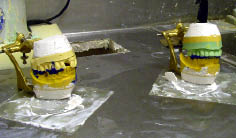Next story: Permutated Pasts: An Interview with Daniel Borzutzky
A Bite Into Architecture
by Albert Chao

Last year, a unique collaboration between dentistry and architecture began to open links between the two disparate fields. Shahin Vassigh and Omar Khan, both assistant professors of architecture at the University at Buffalo, used digital technology to create a dentist’s teaching tool for Lida Radfar, assistant professor at UB’s dental school. Vassigh, Khan and Radfar, through their collaboration, reveal that dentistry and architecture have some correlations.
On a recent visit to the dentist, I found casting, in particular, to be an important process in both fields. Casting in concrete, metal, plaster, glass or any other architectural materials is similar to the casting in dentistry. Teeth—like foundations, steel I-beams and reinforced concrete—are exposed to everyday stresses. The casting process in the dental laboratory repairs the small, but important natural architecture of teeth.
Casting is a process where material, typically in a liquid state, is formed and hardened by being poured into a mold or a framework. For architecture, casting is essential. Cement and concrete are common cast architectural materials. So is molten metal poured into forms that include I-beams and other structural elements. Glass, plastic and other various materials are also casted, each material serving different purposes: connections, frames, etc.
Dentists use different methods of casting. In filling a cavity, a dentist creates a mold by drilling a hole. The material used to cast into this mold is a self-hardening mixture of silver, tin, copper alloy powder and liquid mercury, referred to as a dental amalgam. A cavity filling is site-specific, meaning each cavity determines a similar, yet different approach. The filling is an oral repair, meant to resist the everyday forces and stresses of chewing and biting.
Like teeth, different aspects of architecture are often in need of repair. Holes in walls are repaired with spackle. Concrete that breaks down from weathering results sometimes in sections being replaced entirely. Potholes are patched with gravel. Though these processes occur on a larger scale, the principle is the same as filling a cavity.

Crowns and dentures present a different kind of casting. At Dental Tech Laboratory, a dental lab in Buffalo, owner Andy Jakson gave a rudimentary crash course in the making of crowns and dentures. Dental Tech provides these for more than 300 dentists in the area. Among technicians busy with tiny drills and tools, Jakson equated the practice to art: “You have to be good with your hands,” he said. “It’s an art form. It’s a usable sculpture.”
Crowns are used both when a tooth is chipped and when a cavity has become too large to be filled. Crowns are usually metal on the inside and porcelain on the outside. To make a crown, the dentist makes a mold with a rubber material from an impression of the teeth. This mold process is similar to that used by sculptors and architects to build forms and models.
This rubber mold is sent to the dental lab, where technicians reconstruct a positive of the mouth by casting into the mold a material that hardens to a stone-like material. Wax is then molded to reconstruct the damaged tooth. The wax is packed in a material that resists high heat; the wax melts away, leaving a negative. This process, called lost wax, is a technique used in casting metals, including pieces in bronze, iron or aluminum. In a small crucible, alloy is then heated and poured into the mold. A positive of the tooth is created that will fit over the damaged tooth. The porcelain is then laid atop the metal, polished and hand-painted to mimic the natural aspects of a real tooth. This tooth is then cemented by the dentist to the damaged tooth.
The process of making dentures is similar to that of crowns. An impression is taken of the gum lines. A wax mold is made from the impression, and teeth are inlaid into the wax mold and held together with metal. The wax is prepared so that it mimics the natural contours of the gums, and then taken to a device where a plastic material, instead of hot metal, replaces the wax.

Dentistry, whether in cavity fillings, crowns or dentures, uses the same molding techniques that are used in constructing the built environment. So next time, when under the dentist’s light, don’t panic when the drilling starts. It’s architecture.
Pecha Kucha
Pecha Kucha returns to Buffalo of Friday, February 2. This is Vol. 2.
For those who missed Vol. 1, a slew of designers, architects and artists stormed Soundlab. Each presenter showed 20 images, each for 20 seconds, totaling six minutes 40 seconds. Everyone was on their feet; they had to be in order to see over the crowd.
Originating in Tokyo with architects Astrid Klein and Mark Dytham, the success of Pecha Kucha has been international. The word has also spread in Buffalo, and Pecha Kucha Vol. 2 promises to be even better than the first go-round. The doors open at 7pm and the presentations start at 8:20. Vol 2. presenters are J.T. Rinker, Carolyn Tennant, Titusz Tarnai, Mark Shepard, James Brucz, Matt Hume, Bill Helm, Courtney Grim, Darren Adair, Carl Burdick, Sarah Paul and Don Paul Swain.
For more information, visit www.pechakuchabuffalo.com.
|
Issue Navigation> Issue Index > v6n5: Who'll Stop the War? (2/1/07) > A Bite Into Architecture This Week's Issue • Artvoice Daily • Artvoice TV • Events Calendar • Classifieds |









 Current Issue
Current Issue